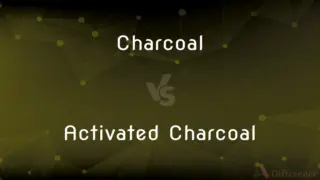Truncate vs. Delete — What's the Difference?
By Tayyaba Rehman & Maham Liaqat — Updated on May 15, 2024
Truncate shortens or cuts off part of something, often keeping a defined structure, whereas delete completely removes something, leaving no trace behind.

Difference Between Truncate and Delete
Table of Contents
ADVERTISEMENT
Key Differences
Truncate means to shorten something by cutting off a part of it. In data contexts, truncating a file or table means reducing its size while retaining its structure. This can be useful when you need to remove unnecessary parts but keep the core intact. On the other hand, delete means to completely remove something from existence. When you delete a file, it is erased entirely and cannot be accessed unless recovered from a backup.
Truncation often retains the integrity of the remaining data. For example, truncating a number by removing digits after the decimal point still keeps it as a valid number. Conversely, deleting data means it's entirely removed from the dataset, which can affect overall data integrity and completeness.
In databases, truncating a table removes all rows but keeps the table structure and its attributes intact, making it quicker and less resource-intensive. Deleting rows from a table removes specified data based on conditions, which can be slower as it often involves logging each deletion.
Truncate operations are generally irreversible in terms of recovering the truncated part, though the remaining data remains usable. Delete operations are often reversible, provided a backup exists, allowing for the possibility of data recovery.
In programming, truncating a string means cutting it to a specified length while maintaining part of the original string. Deleting a string variable removes the variable itself from memory, freeing up space and preventing further access.
ADVERTISEMENT
Comparison Chart
Definition
Shortens or cuts off part of something
Completely removes something
Data Retention
Keeps structure and remaining data
Removes data entirely
Database Operation
Removes all rows but retains table structure
Removes specific rows based on conditions
Reversibility
Generally irreversible, but remaining data is usable
Often reversible if backups are available
Programming Context
Shortens a string to a specified length
Removes a variable from memory
Compare with Definitions
Truncate
To reduce the length of a numerical value.
The decimal number was truncated to two places.
Delete
To withdraw or take out something.
The user account was deleted permanently.
Truncate
To cut off the top or end of something.
The tree branches were truncated.
Delete
To cancel or annul.
The scheduled event was deleted from the calendar.
Truncate
To limit the number of elements in a data set.
The list was truncated to the first ten items.
Delete
To remove characters or data entries.
The typo was deleted from the document.
Truncate
To shorten or reduce
The script was truncated to leave time for commercials.
Delete
To remove entirely from existence.
He deleted the old files from his computer.
Truncate
To shorten (a number) by dropping one or more digits after the decimal point.
Delete
To erase from memory or storage.
The email was accidentally deleted.
Truncate
To replace (the edge of a crystal) with a plane face.
Delete
To cancel, strike out, or make impossible to be perceived
Deleted the expletives from the transcript with a marker.
Truncate
Appearing to terminate abruptly, as a leaf of a tulip tree or a coiled gastropod shell that lacks a spire.
Delete
To remove from a document or record
Deleted the names from the computer file.
Truncate
Truncated.
Delete
To remove (a file, for example) from a hard drive or other storage medium.
Truncate
(transitive) To shorten (something) by, or as if by, cutting part of it off.
Delete
To remove, get rid of or erase, especially written or printed material, or data on a computer or other device.
Truncate
To shorten (a decimal number) by removing trailing (or leading) digits.
Delete
To defeat or dominate.
Truncate
(geometry) To replace a corner by a plane (or to make a similar change to a crystal).
Delete
To kill or murder.
Truncate
Truncated.
Delete
(computing) A deletion.
Truncate
Having an abrupt termination.
Delete
(recorded entertainment industry) A remainder of a music or video release.
Truncate
To cut off; to lop; to maim.
Delete
(uncountable) Delete
Truncate
Appearing as if cut off at the tip; as, a truncate leaf or feather.
Delete
(computing) The delete character (U+007F or %7F).
Truncate
Replace a corner by a plane
Delete
To blot out; to erase; to expunge; to dele; to omit.
I have, therefore, . . . inserted eleven stanzas which do not appear in Sir Walter Scott's version, and have deleted eight.
Truncate
Approximate by ignoring all terms beyond a chosen one;
Truncate a series
Delete
Remove or make invisible;
Please delete my name from your list
Truncate
Make shorter as if by cutting off;
Truncate a word
Erosion has truncated the ridges of the mountains
Delete
Wipe out magnetically recorded information
Truncate
Terminating abruptly by having or as if having an end or point cut off;
A truncate leaf
Truncated volcanic mountains
A truncated pyramid
Delete
Cut or eliminate;
She edited the juiciest scenes
Truncate
To shorten by cutting off a part.
The long title was truncated for the summary.
Truncate
To limit text length in databases.
The database field truncates text after 255 characters.
Common Curiosities
How does delete differ from truncate in SQL?
Delete removes specific rows based on a condition, whereas truncate removes all rows without logging individual deletions.
Is deleting a file the same as truncating it?
No, deleting a file removes it entirely, while truncating would shorten its content without removing it completely.
What does truncate mean in databases?
Truncate removes all rows from a table but retains its structure and attributes.
Can delete operations be undone?
Yes, if a backup is available, delete operations can often be undone.
Does truncating a string affect its length?
Yes, truncating a string reduces its length to a specified number of characters.
Can truncated data be recovered?
Generally, no. Once data is truncated, the cut-off portion is lost.
When should I use truncate instead of delete?
Use truncate when you need to quickly remove all data from a table but keep its structure for future use.
Does truncating a log file reduce its size?
Yes, truncating a log file removes part of its content, reducing its size.
Are truncate operations faster than delete operations?
Yes, truncating is generally faster because it doesn't log individual row deletions.
Is deleting a variable in programming permanent?
Yes, deleting a variable removes it from memory, freeing up space.
Is deleting data secure?
Deleting data can be secure if followed by proper data wiping or shredding processes.
Does deleting an entry in a database free up space immediately?
Not necessarily; the space might be reused by the database, but not immediately freed.
What happens to indexes when a table is truncated?
Indexes are reset but retained when a table is truncated.
What is a common use case for truncating data?
Truncating data is common in maintaining logs by removing old entries while keeping recent ones.
How do truncate and delete impact database performance?
Truncate is less resource-intensive and faster, while delete can be slower and more resource-consuming due to logging.
Share Your Discovery

Previous Comparison
Check vs. Checkmark
Next Comparison
Teaching vs. IndoctrinationAuthor Spotlight
Written by
Tayyaba RehmanTayyaba Rehman is a distinguished writer, currently serving as a primary contributor to askdifference.com. As a researcher in semantics and etymology, Tayyaba's passion for the complexity of languages and their distinctions has found a perfect home on the platform. Tayyaba delves into the intricacies of language, distinguishing between commonly confused words and phrases, thereby providing clarity for readers worldwide.
Co-written by
Maham Liaqat










































